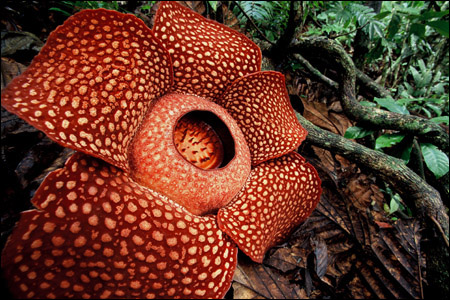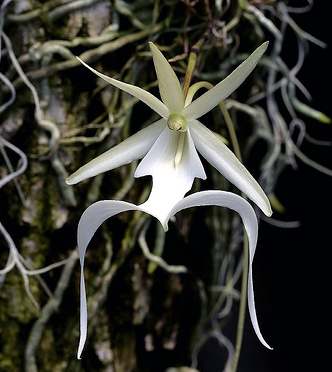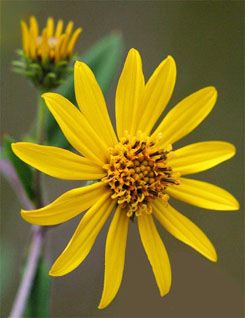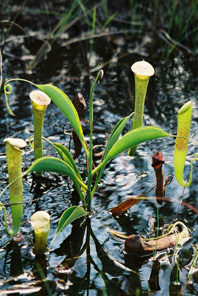Its no doubt that spring and summer bring about some very vibrant and attractive colours.
The insects and wild animals are out-and-about, and a whole host of flowers and plants become alive. So in this list, we look at some rare flowers, whose future seems uncertain. In fact the only chance you may have to have a glimpse at some of these, is through that of a photo.
1. Corpse Flower
This interesting flower is the largest individual flower on earth. Occurring in Indonesia, it was nationally considered a rare flower in 1993.
Months can pass while the flower buds, after reaching bloom, the flower will last for roughly a week before dying. Because of this, the flower can be particularly hard to locate.
Months can pass while the flower buds, after reaching bloom, the flower will last for roughly a week before dying. Because of this, the flower can be particularly hard to locate.
2. Franklin Tree
A very rare plant, the franklin tree is the sole species in its genus, and is native to the Altamaha River valley in Georgia in the south-eastern United States.
All the Franklin trees known to exist today are descended from the seed collected by William Bartram (who saved the species from going extinct in the wild) and propagated at Bartram's Garden in Philadelphia.
They can grow up to a height of 10m, and the seed capsules take 12-14 months to mature, with the plant then living up to and over 100 years.
3. Ghost Orchid
The ghost orchid is a rare plant and is not to be confused with the Eurasian ghost orchid.
The flower was thought to be extinct for a period of nearly twenty years, until recently when it was rediscovered. It is an endangered species and is close to impossible to propagate.
It has no leaves and doesn't use photosynthesis, it needs a specific fungus to be in close contact with its root system for nourishment.
It only blooms when conditions are just right, making this a very elusive flower to find.
4. Middlemist Red
Despite its name, the middlemist red is actually bright pink, and is probably the rarest flower in the world. There are only two known specimens left: one in Britain and one in New Zealand.
The one in Britain was imported from China some 200 years ago by a British Gardener named John Middlemist (whom the plant got its name from).
At the time of John Middlemist, the plant was sold to members of the public as-well, so it is very possible that someone could have one in his/her garden.
The plant has since been totally wiped out in China.
5. Cape Sundew
The cape sundew is a carnivorous plant that is native to the Cape of South Africa. The sundew is covered in many sticky tentacles that are used to trap arthropods.
When prey lands on this plant, the leaves roll towards the centre having as much contact with it as possible, which aids in digestion. The process is relatively quick, lasting for about thirty minutes.
6. Schweinitz's Sunflower
Schweinitz's sunflower is one of the rarest flowers, with only 90 known populations left, many of which contain less than 40 flowers. The species is named after its discoverer, the clergyman and botanist Lewis David von Schweinitz.
The plant can grow from one metre up to four metres, and flowers for two to three weeks in early October.
7. Seven-Son Flower
The seven son flower is native to China and can also be found in non-desert areas of the United States.
The flowers start to blossom in late summer, turning fuschia that last well into the autumn. The pale, peeling bark can be exposed by pruning the lower branches of the interior.
It is a popular ornamental plant that gives off an intoxicating aroma.
8. Showy Lady's Slippers
The showy lady's slipper, can also be called the queens slipper or the pink-and-white-lady's slipper.
While the plant has never been common, it has vanished from much of its historical range as a result of habitat loss. Its habitat is restricted to the north-east region of the United States and the south-east regions of Canada.
Charles Darwin took an interest in the plant for a number of years, and like many - he was unsuccessful in cultivating the plant.
9. Wild Blue Lupine
The wild blue lupine can stand at 0.3-1.5m tall, and as a result of the revolution of industrialisation, the species is on the decline. It is estimated that the number has dropped 90% since 1900.
The remaining habitat is commonly fragmented, and so limits the range the plant can reproduce.
10. Nepenthes Tenax
The nepenthes tenax is a species of the lowland tropical pitcher plant. The plant grows to a height of around 100cm and has a self-supporting stem.
It is a carnivorous plant that can eat small rodents such as a rat. All pitcher plants feed on insects, with anything more complex and of greater size results with the death of the plant. However, this seems to be the exception.
I don't claim ownership or credit for the pictures, all credit is reserved for the original owners. No copyright intended, if you have an issue with a picture that is present, then please contact me.
It is a carnivorous plant that can eat small rodents such as a rat. All pitcher plants feed on insects, with anything more complex and of greater size results with the death of the plant. However, this seems to be the exception.
I don't claim ownership or credit for the pictures, all credit is reserved for the original owners. No copyright intended, if you have an issue with a picture that is present, then please contact me.








Tidak ada komentar:
Posting Komentar